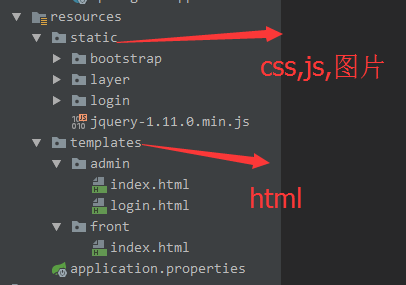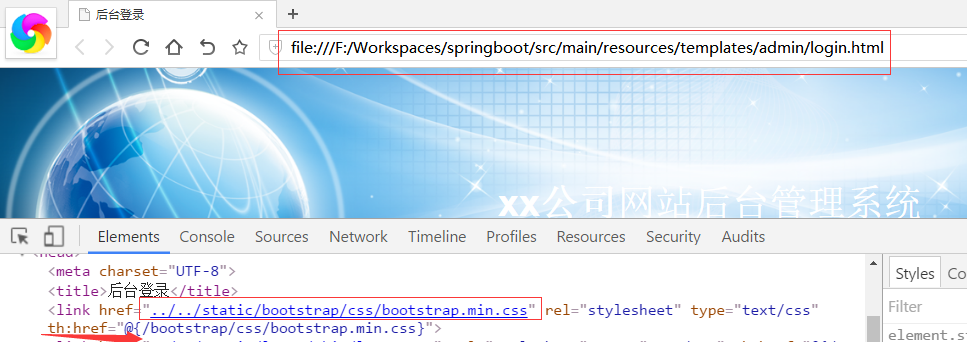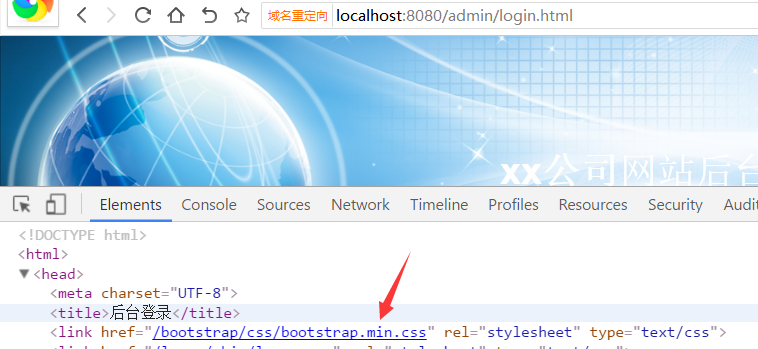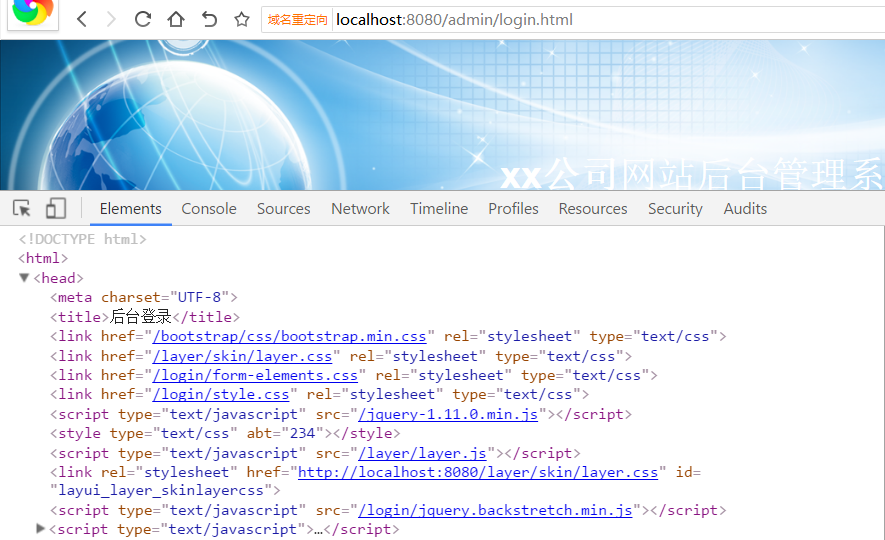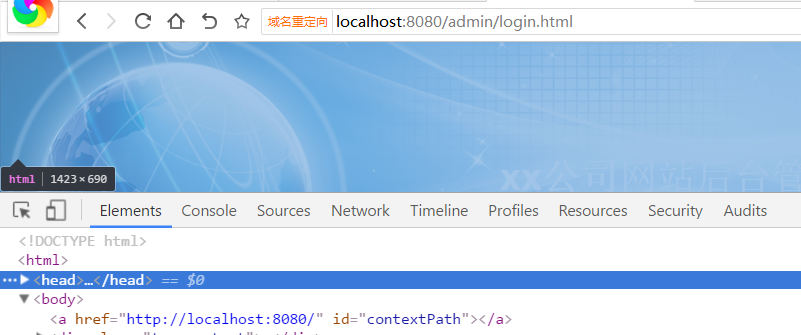IntelliJ IDEA 學習SpringBoot(2) thymeleaf 資源訪問和路徑寫法
上一篇檔案 我們介紹了 IntelliJ IEDA工具建立 SpringBoot 以及 模板引擎 thymeleaf的簡單用法。今天這篇 介紹 如何使用 thymeleaf 訪問靜態資源 如css,js,圖片之類的。
這次我們打算寫一個登入頁面,那麼我們需要匯入css,js之類的東西。首先靜態資源預設放在哪呢?
預設static放資源,如css,js,圖片等。 templates放html。這些都是 springboot預設配置。我們這裡不做修改,預設就預設唄。你改了位置也不見得有多了不得。
我們知道html檔案如果引用css或者js,通常是採用相對路徑,如下:
<link href="../../static/bootstrap/css/bootstrap.min.css" rel="stylesheet" type="text/css" />
效果圖就是下面這樣:
但是如果是web應用,我們用localhost的形式訪問,又會發生什麼呢。
這說明什麼,說明在web應用中,static就是根路徑了,所以不能出現static。
那這又怎麼解決呢。 thymeleaf是這樣解決的。
<link href="../../static/bootstrap/css/bootstrap.min.css" rel="stylesheet"補上th:hreftype="text/css" th:href="@{/bootstrap/css/bootstrap.min.css}"/>
th:href="@{/bootstrap/css/bootstrap.min.css}"/>
就相當於所有的關於路徑都有前面加上 th: 什麼的。事實上還有 th:src,th:attr什麼的。
那麼接下來又發生什麼呢。
如果是本地開啟html,識別不了的th:href就直接展示,因為html元素的屬性是可以任意拓展的,識別不了就直接展示。那接下來看localhost:8080訪問是怎樣的呢
完美解決。當然js同樣道理
<link href="../../static/bootstrap/css/bootstrap.min.css" rel="stylesheet" type="text/css" th:href="@{/bootstrap/css/bootstrap.min.css}"/> <link href="../../static/layer/skin/layer.css" rel="stylesheet" type="text/css" th:href="@{/layer/skin/layer.css}"/> <link href="../../static/login/form-elements.css" rel="stylesheet" type="text/css" th:href="@{/login/form-elements.css}"/> <link href="../../static/login/style.css" rel="stylesheet" type="text/css" th:href="@{/login/style.css}"/> <script type="text/javascript" src="../../static/jquery-1.11.0.min.js" th:src="@{/jquery-1.11.0.min.js}"></script> <script type="text/javascript" src="../../static/layer/layer.js" th:src="@{/layer/layer.js}"></script> <script type="text/javascript" src="../../static/login/jquery.backstretch.min.js" th:src="@{/login/jquery.backstretch.min.js}"></script>
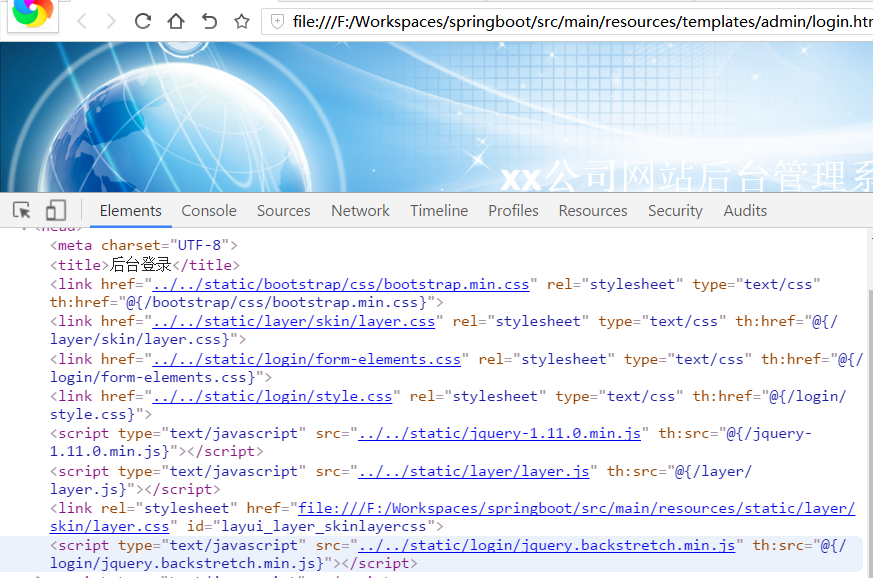
那麼資源訪問,這塊感覺使用thymeleaf模板引擎是要比jsp引擎要好,至少可以做到本地可以直接瀏覽頁面效果,做到前段和後端的分離。
那麼是不是所有問題都解決了呢。我原本也這樣以為,但突然我用了一個外掛jquery.backstretch.min.js。用來讓圖片全屏作為背景的。那麼這個是要在指令碼中訪問圖片url。我們看看遇到怎樣的難題。
<script type="text/javascript"> $(document).ready(function () { $.backstretch("../../static/login/1413012235-43G.png");這是 外掛的基本用法
$.backstretch("圖片路徑")
但是這就頭疼了。如果寫成上面,本地的可以,但localhost:8080方式肯定不行。
$.backstretch("/login/1413012235-43G.png");如果這樣,localhost:8080的方式肯定可以,但是本地的相對路徑就是錯誤的。
那麼這個問題,我們難道就只能二者選擇其一嗎? 有解決辦法的。
我們可以使用類似jsp中的contextpath來解決。解決方法如下。定義如下標籤。
<a href="../../static" th:href="@{${#httpServletRequest.getScheme()}+ '://' + ${#httpServletRequest.getServerName()}+ ':'+${#httpServletRequest.getServerPort()}+${#httpServletRequest.getContextPath()}+'/' }" id="contextPath"></a>這個a標籤是不用展示在頁面上的。 我們看到 我寫了 href和th:href。相當於本地和伺服器兩種方式。稍微解釋一下。@{ }是thymeleaf訪問url路徑的寫法。${}訪問變數值的寫法。 那麼既然jsp有9大內建物件,thymeleaf同樣也有類似內建物件的說法,不只9個哦。
@{
${#httpServletRequest.getScheme()}
+ '://' + ${#httpServletRequest.getServerName()}
+ ':'+${#httpServletRequest.getServerPort()}
+ ${#httpServletRequest.getContextPath()}+'/'
}
上面的就是獲得web應用的contextPath。看到我給上述a標籤一個id為contextPath了嗎?那麼指令碼中訪問就 簡單多了。
var contextPath = $('#contextPath').attr('href'); $.backstretch(contextPath+"/login/1413012235-43G.png")// 完美解決那麼路徑問題也就完美解決了。
好了,本篇關於 thymeleaf 資源和路徑 的相關問題 就記錄到這了。

